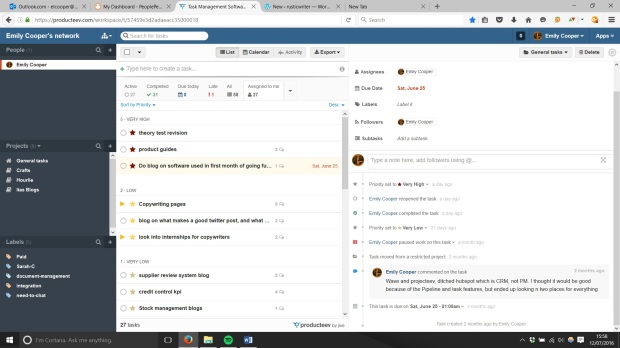“Learning to be a young lady has never seemed so dangerous.”
– Mary Robinette Kowal, Hugo Award winner
Upon opening the beautifully illustrated red cover, I knew I was in for a treat. Emma Newman’s first novel with Angry Robot Books Between Two Thorns. It’s a story of Cathy’s coming of age, and the politics between the Fae and the groups of magicians and arbiters in Bath- and the Fae mirror City Aquae Sulis.
Layered, like every fae promise, with conditions and tangles, until the fates of the main characters are bound up together. So neat, so cunning. Two chapters in, and it was turning out to be exactly my kind of book.
The Main Characters
Although we spend most time with Cathy, there is a number of characters, and between chapters we switch between viewpoints. Each time this happens, the plot thickens.
Cathy- the fae who wants to be human. Unfortunately for her, she’s been born to a rich noble family, and is expected to make a good marriage. She’s a rebel. For her coming of age she requested to go to University. After getting her wish, she runs away, in order to stay. She is betrayed (and not for the first or last time) by her boss, a shop keeper. Against her will she is brought back to her home by Lord Poppy. He seems to act simply for his own amusement – especially when it makes Cathy’s life harder.
Sam- just a guy in the wrong place at the wrong time. He’s an innocent, witness to something beyond his understanding. He likes a beer at the end of the day, and struggles with his marriage. He doesn’t want to ruin what he has… but it hasn’t helped that he took a leak at his wedding day, illuminated on the side of the marquee.
Max- an arbiter (who police the acts of the Fae.) He’s a down-to-earth kind of guy with a strong moral compass… without a soul. All arbiter’s have their souls kept in jars at their headquarters. But when the Bath HQ blows up, he’s the only one left to deal with the current crisis. Max’s life now focuses on Gargoyles, pain-killers and a mad librarian.
The Plot- WARNING: spoilers ahead
We begin with Sam the hapless human. Drunk, he stumbles from the pub and goes into an alleyway to relieve himself. He continues walking onto an old estate and witnesses two men, oddly tall, impossibly strange carrying something through the garden. A something large enough to be a body. He waits, trying to be stealthy. They find him, but don’t kill him, deciding instead to place him under a magical contract. He will be unable to talk about what he saw.
Then we meet Cathy. It’s her last day at work, and she is betrayed to Lord Poppy by her boss. Hidden from her family and all Fae, her boss protected her, even cast the simple charm to keep her safe. Despite her wishes she must become the fae lady she was born to be.
True to the crazy-paving nature of the chapters, we jump to another character- Max, the arbiter. The only a arbiter left in Bath after a freak accident, the Fae of Bath take advantage. They let their magic run riot, and there is no one but Max and a few allies to protect humans, fae or arbiters.
A volley of questions are thrown into the reader’s mind, and the plot matches the complexity of a fae’s lying tongue. The ‘uncorruptable’ Arbiters have been corrupted. Who is kidnapping mortal blondes, and what does this have to do with Max?
Meanwhile, Cathy has been ‘gifted’ with 3 wishes, which must impress the fae lord Poppy and be given before the first ball of the season- which, did I mention, is only a few days away? Or she’ll be turned into a walking puppet for eternity. Now that the spell hiding her has been removed, Tom catches up with her. He’s Cathy’s brother, and has been hunting for her for years. She doesn’t run. She’s calm, collected, and makes a cup of tea.
Then at chapter eleven the writing slumps. Another main player in the plot is introduced, a man from the Rosa family. He demands that he be repaid for Cathy’s first misspent wish. Causing him to lose out on a beautiful mortal lady. It seemed a little contrived, and just an attempt to make the first ball of the season a little more interesting. I was not convinced about these character’s motivations. It was farcial, and didn’t keep with the serious magical atmosphere of the rest of the book.
At the ball, Lord Poppy hurries Cathy along with her final wish and is reunited with her parents and her fiancee. (I think they’ll actually be a good for each other.)
Sam ‘the loveable drunk human’ is cornered by Max and the librarian, and asked to talk about what happened – but all his words turn into nonsense fiddle-de-dee. They use Cathy to break the spell on Sam and all converge at the party to solve the mysteries they are faced with.
At this point the worries of Max and Sam weren’t really getting to me. I wanted more reasons to care about them, but as a recently non-teen girl, I must suppose I sympathise with Cathy, who begins to re-learn the tricks of the Fae and kick ass.
What happens then? I’m trying not to spoil the ending, but I can assure you that it was a firework display of plot lines, criss crossing, finishing and beginning anew.
The next book in the series is out now. I must get my hands on a copy.
My Rating
I’m going to give this book four out of five. The ending felt a little rushed (perhaps that was just my reading speed), and in places the plot didn’t really seem logical. I like a plot that I don’t expect, but makes me sit up and say ‘Of course, yes, that is exactly how it should go.’
If you’d like to know more about the series or find a copy, go to:
http://angryrobotbooks.com/our-authors/emma-newman/
Originally published on Heart Of Glass online








